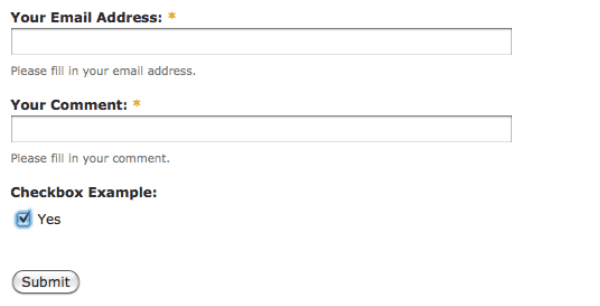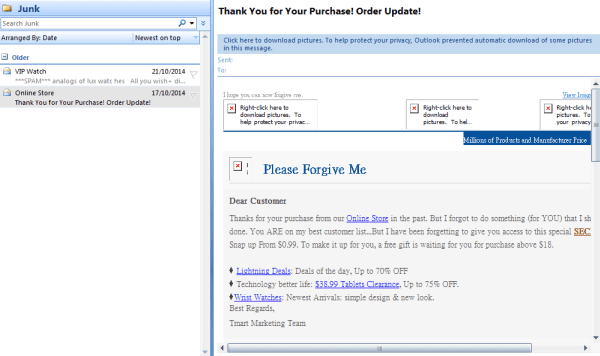Email marketing is such a valuable tool in your marketing strategy. It’s a way to directly talk to your customers in a place they’re happy to receive information, because they said “yes” to hearing more from you. They want to hear what you have to say, and since they gave you their data, you can send them relevant emails that fit their profile and include personalized details.
It’s quick and easy to set up – especially if you use an automation tool. Plus, you’re able to see the data on your individual customers and track what content they’re interested in, as well as report the financial results back to the bosses.
Unfortunately, there are companies out there that have exploited this brilliant marketing channel and brought the practice to the verge of a bad reputation. Spammers send emails to anyone they can get their hands on, no matter how they obtained the data. Sometimes the content is for a genuine company but they’ve just disregarded the rules around email marketing. But sometimes they are criminals who try to swindle the unsuspecting out of money.
- 1 The Law
- 2 1. Opting In
- 3 2. Don’t Use False Or Misleading Header Information
- 4 3. Don’t Use Deceptive Subject Lines
- 5 4. Identify The Message As An Ad
- 6 5. Tell Recipients Where You’re Located
- 7 6. Tell Recipients How To Opt Out Of Receiving Future Email From You
- 8 7. Honor Opt-out Requests Promptly
- 9 8. Monitor What Others Are Doing On Your Behalf
- 10 9. Commercial Email Definition
- 11 10. Forward-to-a-friend Schemes
- 12 Wrapping Up
The Law
Laws have now been put in place that prevents this kind of business, mainly through the CAN-SPAM Act of 2003. This was put in place by President George Bush as a way of setting the national standard for sending commercial email. It’s short for Controlling the Assault of Non-Solicited Pornography And Marketing and is a play on words to “can” i.e. get rid of the spam.

The law has made email marketing a little trickier for companies, but has reassured customers that their inboxes won’t be full of irrelevant or dangerous spam upon opening. Since the laws were made, trust has slowly been building back up and customers are happier to give their email address and other data to companies that they want to hear from. So we’re back in the loop where those addresses that you do hold and can legitimately market to are like gold.
To make sure you don’t risk breaking the law and upsetting your customers with your email marketing, it’s vital that you’re clued into the legal stipulations. It’s $16,000 per violation per individual email sent, so you really don’t want to be getting on the wrong side of the law here!
It’s useful to know the full details as you could lose out on taking advantage of email marketing if you think it’s too complicated to use. Rules are rules, and they need to be followed. But they are easy to manage once you’re familiar.
Here are the 10 Email Marketing Spam Laws You Need to Know:
1. Opting In
A customer’s consent to receiving information from you can be oral or written. The written side includes ticking a checkbox on a web form.

2. Don’t Use False Or Misleading Header Information
Customers have a right to know who the email has come from, so your “From”, “To”, and “Reply To” must represent your company; or specifically, the company or individual who sent the message. Your routing information must also be clear, including the origination domain name and email address.
3. Don’t Use Deceptive Subject Lines
An old-time spammer knows that intriguing subject lines are the easiest way to get people hooked in, including the “You’re a winner” email that almost every inbox has seen. Instead, the subject line must accurately reflect the content of the message. If the offer inside is 10% off, for example, your subject line can’t suggest a higher percentage.

4. Identify The Message As An Ad
Most customers know an advert when they see one and quite often ignore it because of this. Marketers have therefore developed techniques over the years to be more inconspicuous so that the advert or message looks more like a recommendation than an advert. However, the CAN-SPAM Act requires you to let your customers know the email is an advert. Again, it’s all about making sure they aren’t deceived.
5. Tell Recipients Where You’re Located
This gives your customers another way to contact you and shows that you’re a real company, which builds trust. The message must include a valid postal address. So this could be your company’s street address or if your work address is also your home address, you can use a post office box you’ve registered with the U.S. Postal Service or private mailbox you’ve registered with a commercial mail receiving agency established under Postal Service Regulations.
6. Tell Recipients How To Opt Out Of Receiving Future Email From You
Email marketing is always about the customer’s choice. It should be their choice to sign up to hearing more from you and their choice to decide they’ve had enough. Make it clear on your email message that the recipient can opt out of getting email from you in the future and give instructions how to do so. It’s no use trying to make this message or the unsubscribe links inconspicuous by using small or transparent fonts; you need to make it easy for them.

You also need to give a return email address or another internet-based way to allow people to let you know their choice. If you provide a menu of choices so the recipient can choose certain communications and not others, there needs to be a “no communication” option. Using an email service provider like Aweber or MailChimp has this service built-in and makes it really easy for you.
7. Honor Opt-out Requests Promptly
Make sure your own spam filter doesn’t stop the opt-out requests coming through. Once you’ve received them, make sure you honor the request within 10 business days. Any opt-out mechanism you offer must be able to process opt-out requests for at least 30 days after you send your message.
You must make opting out as easy as possible, so that means you can’t charge a fee, require personally identifying information beyond their email address, or make them do anything other than request to opt-out. Once you’ve removed the recipient from your list, you’re not allowed to sell or transfer their data to anyone else, apart from any company who you have hired to assist you with the CAN-SPAM Act compliance.
8. Monitor What Others Are Doing On Your Behalf
It’s no excuse to blame the mistake on someone else, so you must keep a watch over any external company that completes your email marketing for you. Both the company that sends the email and the company has a product to sell must comply with the law.
9. Commercial Email Definition
The CAN-SPAM Act defines commercial email as “any electronic mail message the primary purpose of which is the commercial advertisement or promotion of a commercial product or service (including content on an Internet website operated for a commercial purpose).”
The CAN-SPAM Act only applies to commercial mail, rather than transactional or relationship mail. This means that if you send order receipts, warranty information, or changes in membership details via email, for instance, you only need to make sure that your routing information is correct. Be careful if you start to add any advertising messages in these types of emails, as they could fall under commercial.
Also think about where the email links to, as your customer’s final destination on their journey from your email also counts when deciding if the overall message is commercial or not. Usually your website will fall under this definition.
10. Forward-to-a-friend Schemes
If you offer a link so the recipient can forward the email to a friend, you don’t need to worry about the CAN-SPAM Act. However, if you include an incentive for your customer to forward it, like a discount code or the chance to win a competition, then you become responsible for the sending of that email. Therefore, you need to be very careful about adhering to the rules.

Wrapping Up
Any self-respecting company doesn’t want to be a spammer. It’s bad for their reputation amongst customers and the industry, as well as their online reputation with search engines and email providers. It brings down marketing as a practice as a whole – although companies are in competition with each other, they don’t want to be detrimental to the whole industry.
So the best thing to do is to make sure you’re up to date with the laws. Although laws can seem scary and complex, don’t let them put you off from using one of the best marketing channels out there. The CAN-SPAM Act has been set out really clearly and you need to follow it to avoid the hefty fines. However, you’ll find that many of the points are common sense and likely encompass what you’d look for as a consumer yourself.
As I mentioned previously, email marketing is an incredibly valuable part of your marketing mix, from the data you can collect and learn from to the relationship you can build with your customer. Just make sure you give your customers the choice to be in that relationship with you. Knowing these laws will help you to do that.
Were you familiar with these laws before reading this post? Did I miss anything? Please feel free to leave a comment below.
Article thumbnail image by maxicam / shutterstock.com









Good information on staying out of trouble with email marketing. As an owner of site that teaches people how to market their site/product, knowing how to stay out of trouble is vital.
Staying within the complaiance of the act is what people need to pay attention to.
If you discover a reliable partner to source to, this can be far better than doing it in-house. Of course, reliable is that the keyword here. One factor I wouldn’t advocate is to source to very cheap worth company as a result of this sometimes suggests that they won’t be too involved regarding quality and that they can be tempted to try and do the smallest amount resistance route, notwithstanding if it’s legal or not.
This is a really interesting article, I never knew there were law like this. It is actually really nice to know that there are laws protecting us from dangers online. I didn’t know that commercial ads in an email had laws against them. Thank you for such and informative article, I appreciate reading about a subject I’ve never heard about before.
I’m also wondering on how frequent you may send someone emails via job boards.
Is there a limit to a frequency you can send emails to someone? For example, we send emails monthly to candidates on job boards like Monster, CareerBuilder – wasn’t sure if there was any rule we were breaking by reaching BACK out to someone who didn’t respond that they were interested in a job offer NOR did they click our “unsubscribe” link.
Thanks a lot for your great information here. This article of your success to help me here that just try to start apply email marketing. I will try to apply these information to mine and hope it will works 🙂
Thanks again, Brenda.
Thanks – a great article as most of these are often overlooked and clients very often are not aware of any of these.
Here in the great white north, Canada, as of last July you need permission before you can send your first email, then from there you need to provide the same opt out options etc.
I like this article but it might be worth mentioning that other laws exist in other jurisdictions, i.e., if you don’t live in the US it does not necessarily mean that you can ignore the concepts mentioned in this article. The chances are similar local laws will probably apply.
That said, I think in the case of the US, EU, and Canada they’re very similar. Certainly the headline stuff. My limited understanding of EU law is that all of the things mentioned apply here too (with the correction to opt-in not being mandatory as others have mentioned in the comments)
http://www.lsoft.com/resources/optinlaws.asp
I’m sure 90% of your readers are US based anyway but it’s make for a more complete article to reference other laws too.
I’m going to have to share this post with a lot of people. The worst perpetrators are from those countries where the seller has just gotten into online marketing, bought a list and then voila, Spam! I’ve rapped a few knuckes recently and fortunately received apologies and been unsubscribed. Wish certain folks in LinkedIn Groups who know about CANSPAM would also adhere to the same. A recent trend is to connect via a Group and then send out emails which are pure marketing. Off to share.
PS. Thanks for writing the comprehensive post!
For information for those who’d like to know, the legislation in France (and in most of Western Europe countries) is pretty much the same as in the US.
And as others said for the US, the #1 rule you mentioned is not enforced either in France. You just have to ensure that the recipient has a quality for potentially being interested in the content of your email, to stipulate why he/she receives this email, and of course to clearly give directions for opting-out.
Thank you for the information. I’m actually in the process of setting up a newsletter for client and your information was very helpful.
To better enforce your anti-spam compliance you may want to consider Double Opt-in whereby a subscriber’s ownership and control of the submitted email address is authenticated by clicking a confirmation link to be come a Confirmed Subscriber.
Double opt in subscribers also tend generate far better open and click rates.
http://blog.mailchimp.com/double-opt-in-vs-single-opt-in-stats/
Double Opt-in is a great step to take to qualify leads as “action takers” instead of just “fence-sitters” or “information collectors.”
However, nearly all 3rd Party Email List Management services require Double Opt-in except Aweber, who provides the ability to turn this off per list, instead of just globally, so that the right approach can be adopted at the right time.
The expense of running and maintaining email servers, which I do, in addition to integrating such things with any web software like WordPress membership can be daunting, so I think when it’s about mass marketing you’re talking about a specialty niche which may or may not integrate their BI with WordPress. Right? For most WP people I think it’s absolutely sound advice to give a clear Opt-in, and this promotes transparency and trust with your clients, and clients-to-be.
#1 is not true and is a common misconception. The CAN SPAM law does not state that people you email have to opt in or sign up for your email. But you must provide an opt out.
Most marketers are not sending the types of email that CAN-SPAM was created to prevent, and (as written in the Harvard Business Review article linked below) we should not feel constrained in our ability to send unsolicited email to prospects so long as we observe CAN-SPAM regulations.
https://hbr.org/2010/03/b2bs-your-email-policy-could-b
Here’s another very official link:
https://www.ftc.gov/tips-advice/business-center/guidance/can-spam-act-compliance-guide-business
Thanks for the .gov link. It explains everything clearly and officially.
#1 is not part of the law. You should read it before you write about it as an authority.
It’s a common misunderstanding of the CAN-SPAM Act that you must get permission to send a commercial email. In the US, you do not need permission under CAN-SPAM. But you do need to do the other steps you’ve listed. The misunderstanding comes from the requirements most email marketing providers have written into their terms and conditions that state you must acquire permission in order to use their service. They require this because of the white listing agreements they need to maintain with the major ISPs.
What is the link to where to report spammers?
absolute truth …